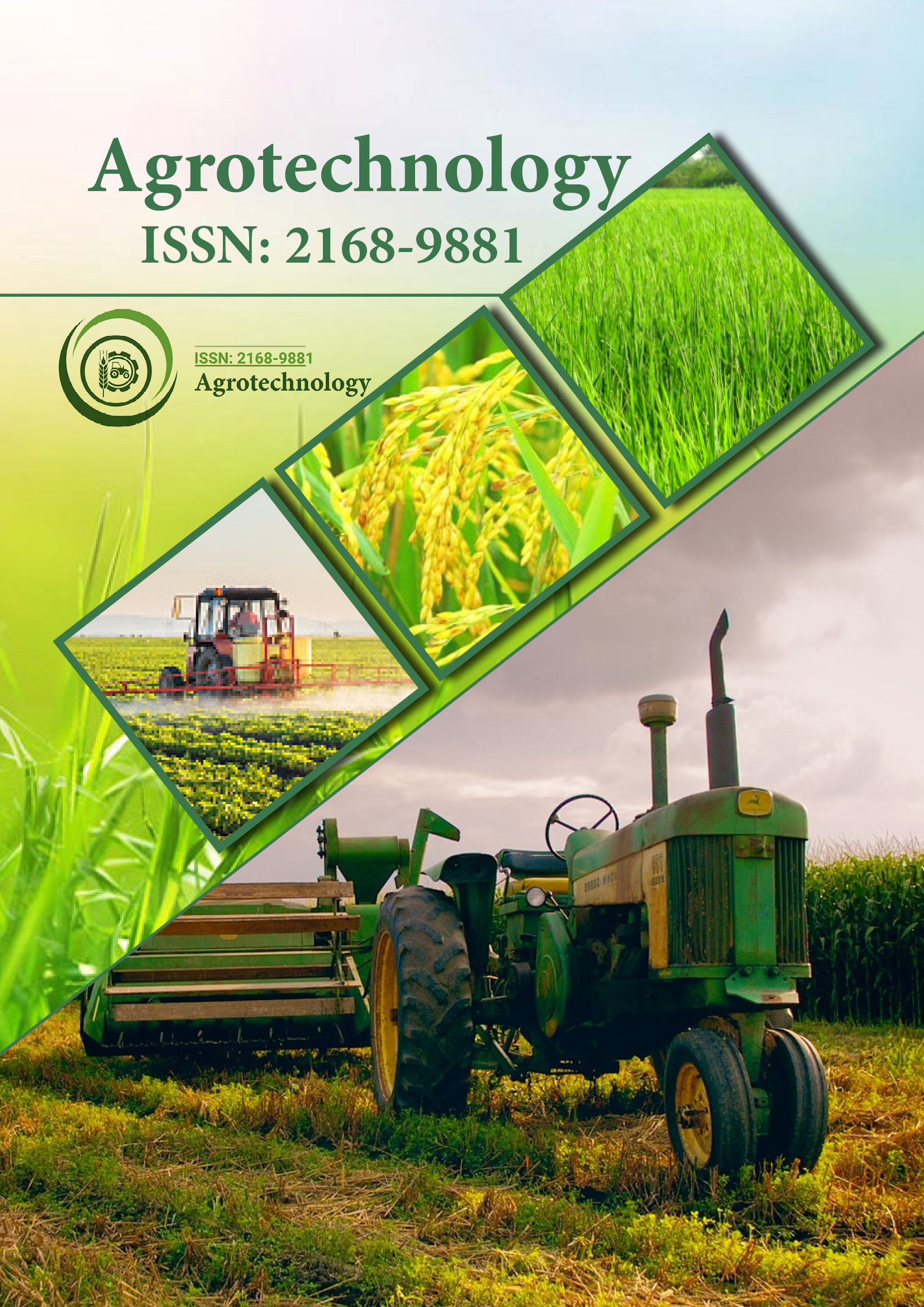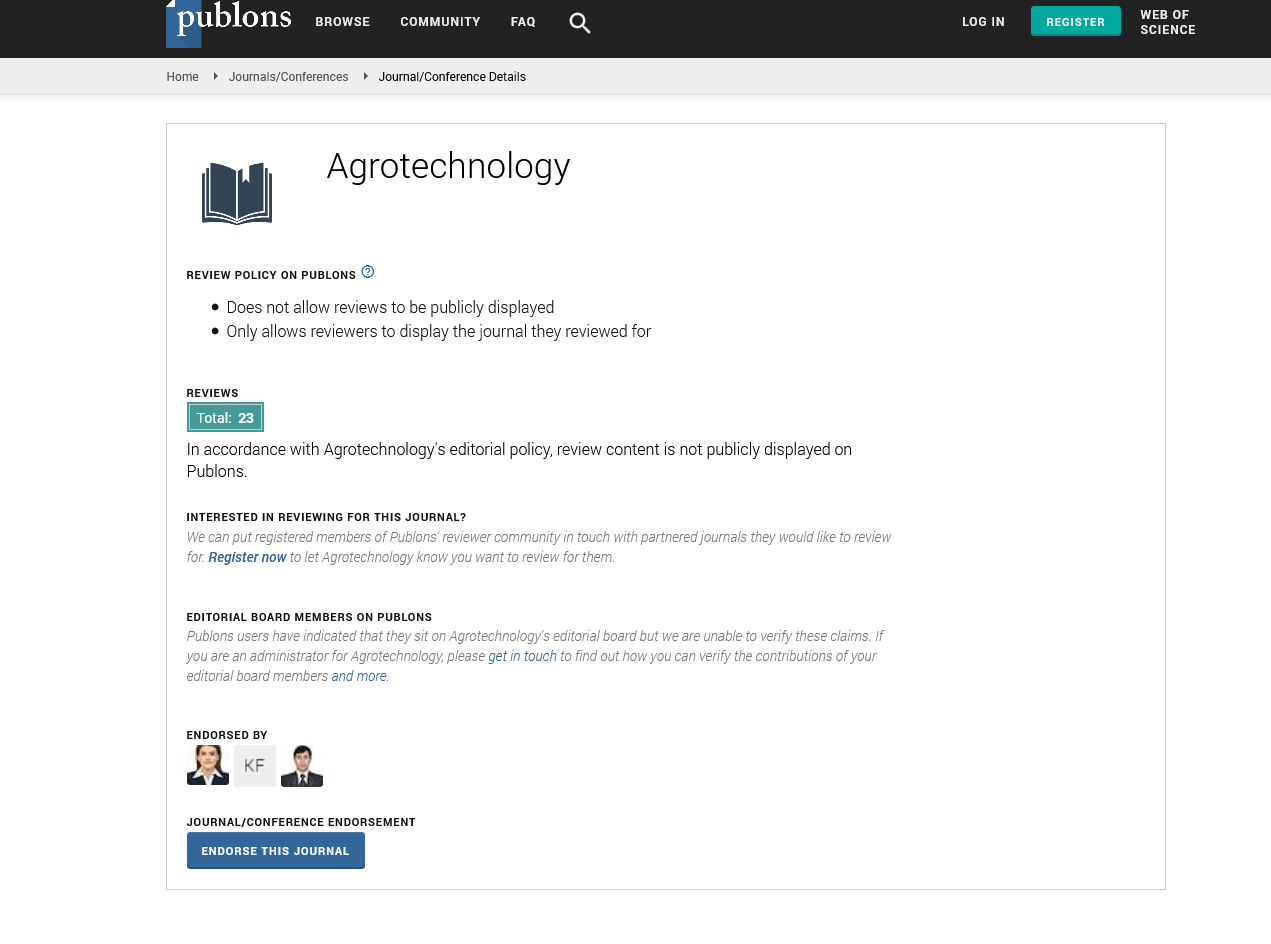Indexed In
- Open J Gate
- Genamics JournalSeek
- Academic Keys
- ResearchBible
- Cosmos IF
- Access to Global Online Research in Agriculture (AGORA)
- Electronic Journals Library
- RefSeek
- Directory of Research Journal Indexing (DRJI)
- Hamdard University
- EBSCO A-Z
- OCLC- WorldCat
- Scholarsteer
- SWB online catalog
- Virtual Library of Biology (vifabio)
- Publons
- Geneva Foundation for Medical Education and Research
- Euro Pub
- Google Scholar
Useful Links
Share This Page
Journal Flyer

Open Access Journals
- Agri and Aquaculture
- Biochemistry
- Bioinformatics & Systems Biology
- Business & Management
- Chemistry
- Clinical Sciences
- Engineering
- Food & Nutrition
- General Science
- Genetics & Molecular Biology
- Immunology & Microbiology
- Medical Sciences
- Neuroscience & Psychology
- Nursing & Health Care
- Pharmaceutical Sciences
Opinion Article - (2024) Volume 13, Issue 4
The Role of Soil Nutrient Analysis: Essential Component of Precision Agriculture
Yu Kiyomi*Received: 29-Nov-2024, Manuscript No. AGT-24-27403; Editor assigned: 02-Dec-2024, Pre QC No. AGT-24-27403 (PQ); Reviewed: 16-Dec-2024, QC No. AGT-24-27403; Revised: 23-Dec-2024, Manuscript No. AGT-24-27403 (R); Published: 30-Dec-2024, DOI: 10.35248/2168-9891.24.13.394
Description
Soil nutrient analysis plays an essential role in precision agriculture, acting as an initial component for optimizing crop production and ensuring sustainable farming practices. This process involves assessing the nutrient composition and fertility of the soil to inform targeted interventions that enhance agricultural productivity. As the demand for food increases alongside global population growth, the need for efficient and effective farming practices becomes paramount. Soil nutrient analysis provides the insights necessary to manage resources more judiciously and to maximize yield potential while minimizing environmental impact.
At the heart of precision agriculture is the principle of tailoring farming practices to the specific needs of the land. Soil nutrient analysis allows farmers to gain a comprehensive understanding of the nutrient availability in their fields. By determining the levels of essential nutrients, such as nitrogen, phosphorus, potassium and various micronutrients, farmers can make informed decisions about fertilization and soil amendments. This personalized approach helps prevent the over-application of fertilizers, which not only reduces costs but also minimizes the risk of nutrient runoff that can harm surrounding ecosystems.
One of the significant advantages of soil nutrient analysis is its ability to identify nutrient deficiencies or imbalances that can impede crop growth. Different crops have varying nutrient requirements and knowing the specific needs of each crop type can guide fertilization practices. For instance, a soil test may reveal low levels of potassium in a field intended for growing potatoes, indicating that potassium supplementation is necessary to achieve optimal growth. By addressing these deficiencies, farmers can enhance plant health and improve overall yields.
In addition to identifying deficiencies, soil nutrient analysis enables farmers to monitor changes in soil fertility over time. Continuous monitoring allows for the assessment of soil health and fertility trends, helping to gauge the effectiveness of implemented agricultural practices. For example, a farmer may observe improvements in soil nutrient levels following the adoption of cover cropping or reduced tillage. By regularly analyzing soil samples, farmers can adjust their management practices based on real-time data, ensuring that they remain aligned with their production goals.
Soil nutrient analysis also plays a vital role in enhancing environmental sustainability. Agriculture is a significant contributor to environmental degradation, particularly through nutrient runoff and soil erosion. By using precision agriculture techniques informed by soil nutrient data, farmers can implement more sustainable practices. For instance, soil tests can guide the application of fertilizers in a manner that matches the nutrient uptake patterns of crops, minimizing excess application. This approach not only protects water quality but also promotes healthier soil ecosystems, ultimately leading to more resilient agricultural systems.
The integration of technology further enhances the benefits of soil nutrient analysis in precision agriculture. Advanced soil sensors and remote sensing technologies can provide real-time data on soil conditions and nutrient levels across large areas. These technologies enable farmers to make timely decisions based on dynamic soil conditions rather than relying solely on historical data. As a result, the precision with which farmers can manage inputs increases significantly, leading to improved resource use efficiency.
Moreover, soil nutrient analysis cultivates a deeper connection between farmers and their land. When farmers engage in the practice of soil testing, they gain insights into the biological and chemical processes occurring in their fields. This knowledge promotes a sense of stewardship and responsibility toward the environment. Farmers are more likely to adopt practices that enhance soil health when they recognize the direct correlation between soil quality and long-term productivity. This engagement can also promote a culture of sustainable farming practices that prioritize ecological balance and resource conservation.
Collaboration among stakeholders further enhances the impact of soil nutrient analysis. Researchers, agricultural extension services and farmers can work together to develop soil management practices that are informed by scientific findings and tailored to local conditions. This collaboration can lead to the development of innovative solutions for soil fertility management, such as the use of cover crops to enhance nutrient cycling or the incorporation of organic amendments to improve soil structure. By utilizing collective knowledge, stakeholders can drive progress in sustainable agriculture.
Additionally, the economic implications of soil nutrient analysis are significant. By optimizing nutrient management, farmers can achieve higher yields and improved crop quality, which can translate to better market prices. Reduced fertilizer costs and minimized environmental penalties associated with overapplication also contribute to improved profitability. Furthermore, as consumers increasingly demand sustainably produced food, farmers who prioritize soil health and nutrient management can enhance their market appeal.
In conclusion, soil nutrient analysis serves as a vital component of precision agriculture, providing the necessary insights for informed decision-making in crop production. By identifying nutrient deficiencies, monitoring soil fertility over time and promoting sustainable practices, soil nutrient analysis enhances agricultural productivity while minimizing environmental impact. The integration of technology and collaboration among stakeholders further amplifies these benefits, leading to a more resilient and efficient agricultural system. As the agricultural sector faces mounting challenges, the role of soil nutrient analysis becomes increasingly important in fostering sustainable food production and ensuring food security for future generations.
Citation: Kiyomi Y (2024). The Role of Soil Nutrient Analysis: Essential Component of Precision Agriculture. Agrotechnology. 13:394.
Copyright: © 2024 Kiyomi Y. This is an open access article distributed under the terms of the Creative Commons Attribution License, which permits unrestricted use, distribution, and reproduction in any medium, provided the original author and source are credited.


